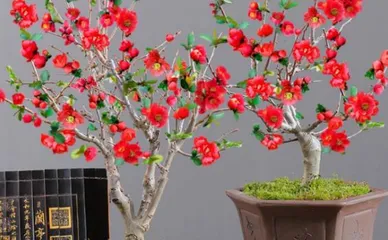Summary:
I: Introduction
In the context of accelerating urban life pace, more and more people choose to decorate their homes with flowers to adjust the living atmosphere. And crabapple flowers, due to their unique shape and brilliant colors, have gradually become objects of attention for many flower enthusiasts. Although crabapples are usually considered outdoor plants, they can actually be well maintained indoors.

II: Preparations
If you want to grow crabapples indoors, your first step is to prepare a suitable environment for their growth. When growing crabapples indoors, you need to choose large pots, ensure containers have adequate drainage holes, and use well-draining soil. You also need to select an area with sufficient sunlight exposure.
III: Better Early Than Late
Crabapples are spring-blooming plants, so if you want to grow them indoors, it's best to plant them in early spring. This allows the flowers to grow vigorously during the appropriate season and ultimately produce beautiful blooms.

IV: Suitable Temperature
Crabapples are flowers that prefer warm environments, so they need to grow at appropriate temperatures. In spring and autumn, indoor temperatures should be maintained between 15°C and 20°C. In summer, this can be increased to around 22°C, while in winter, avoid temperatures below 12°C.
V: Watering
Crabapples need moderate water to maintain normal growth, but not too much moisture. During hot summer periods, increase watering frequency to keep the soil moist. In other seasons, watering once a week is sufficient.
VI: Fertilization
Adequate fertilization can promote the growth and flowering of crabapples. In spring and summer, you can fertilize once a month, but be careful not to over-fertilize to avoid damaging the plants. It's best not to fertilize in winter.

VII: Controlling Indoor Humidity
Besides proper watering, you can also control indoor humidity through other methods. For example, you can place some humidity regulators around the pot or use a humidifier to increase indoor humidity. At the same time, avoid placing crabapples in poorly ventilated areas.
VIII: Timely Pruning
Crabapples grow rapidly, so timely pruning is necessary. In spring and summer, you can appropriately prune branches and leaves to promote new bud growth. Also, remember to remove yellowed leaves promptly.
IX: Preventing Pests and Diseases
Like other flowers, crabapples are susceptible to various pests and diseases. To prevent this, regularly inspect the leaves and roots of the plants, detect problems early, and take appropriate measures. You can also use safe and effective pest and disease control methods.
X: Ample Sunlight
Sufficient sunlight is one of the key factors for normal crabapple growth. When choosing a planting location, select an area with ample sunlight exposure. If there isn't enough natural light indoors, you can use artificial lighting for supplementation.
XI: Proper Ventilation
Crabapples thrive in well-ventilated environments, so when growing them indoors, pay attention to maintaining good air circulation. You can open windows occasionally or use air fresheners to keep the indoor air fresh.
XII: Avoid Cold Temperatures
Cold environments are unfavorable for crabapples. During cold winter months, place crabapples in warmer indoor locations to avoid the effects of low temperatures.
XIII: Timely Repotting
Crabapples grow quickly, so they need to be repotted during their growth process. You can change the potting soil in spring and autumn, replacing no more than 1/3 each time to avoid affecting the growth and development of the crabapples.
XIV: Regular Observation
Growing crabapples indoors requires regular observation of their growth conditions and prompt problem-solving. Pay attention to the leaves and roots of the plants, detect abnormal growth or pest/disease issues early, and take appropriate actions.
XV:
Growing crabapples indoors involves multiple considerations, including light, temperature, water, fertilization, pruning, etc. Only by comprehensively considering these factors can you ensure that crabapples will thrive indoors and add beauty to your home.
```